

Luma (video) In video, luma represents the brightness in an image (the "black-and-white" or achromatic portion of the image).
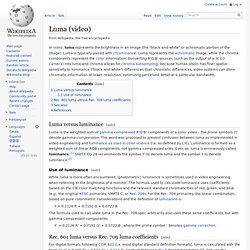
Luma is typically paired with chrominance. Luma represents the achromatic image, while the chroma components represent the color information. Converting R'G'B' sources (such as the output of a 3CCD camera) into luma and chroma allows for chroma subsampling: because human vision has finer spatial sensitivity to luminance ("black and white") differences than chromatic differences, video systems can store chromatic information at lower resolution, optimizing perceived detail at a particular bandwidth. The formula used to calculate luma in the Rec. 709 spec arbitrarily also uses these same coefficients, but with gamma-compressed components: Y' = 0.2126 R' + 0.7152 G' + 0.0722 B', where the prime symbol ' denotes gamma correction. As well, the Rec. 709 luma coefficients may not necessarily provide better performance.
Chrominance. Luminance only, Chrominance only, and full color image. History[edit] The use of two channels, one transmitting the predominating color (signal T), and the other the mean brilliance (signal t) output from a single television transmitter to be received not only by color television receivers provided with the necessary more expensive equipment, but also by the ordinary type of television receiver which is more numerous and less expensive and which reproduces the pictures in black and white only. Previous schemes for color television systems, which were incompatible with existing monochrome receivers, transmitted RGB signals in various ways.
Basics of Video. Basics of Video Analog video is represented as a continuous (time varying) signal.

Digital video is represented as a sequence of digital images. Types of Color Video Signals Component video -- each primary is sent as a separate video signal. The primaries can either be RGB or a luminance-chrominance transformation of them (e.g., YIQ, YUV). Analog Video The following figures are from A.M. NTSC Video 525 scan lines per frame, 30 frames per second (or be exact, 29.97 fps, 33.37 msec/frame) Interlaced, each frame is divided into 2 fields, 262.5 lines/field 20 lines reserved for control information at the beginning of each field So a maximum of 485 lines of visible data Laserdisc and S-VHS have actual resolution of ~420 lines Ordinary TV -- ~320 lines Each line takes 63.5 microseconds to scan.
Composite video. Chroma subsampling. It is used in many video encoding schemes — both analog and digital — and also in JPEG encoding.

Rationale[edit] In full size, this image shows the difference between four subsampling schemes. Note how similar the color images appear. The lower row shows the resolution of the color information. How subsampling works[edit] Color space. A comparison of the chromaticities enclosed by some color spaces.
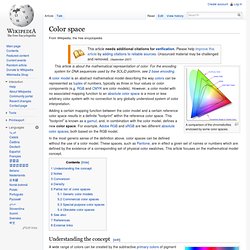
A color model is an abstract mathematical model describing the way colors can be represented as tuples of numbers, typically as three or four values or color components (e.g. RGB and CMYK are color models). However, a color model with no associated mapping function to an absolute color space is a more or less arbitrary color system with no connection to any globally understood system of color interpretation. Digital video.
Digital video is a type of digital recording system that works by using a digital rather than an analog video signal.
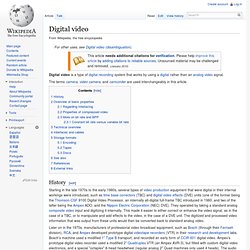
The terms camera, video camera, and camcorder are used interchangeably in this article. History[edit] Starting in the late 1970s to the early 1980s, several types of video production equipment that were digital in their internal workings were introduced, such as time base correctors (TBC) and digital video effects (DVE) units (one of the former being the Thomson-CSF 9100 Digital Video Processor, an internally all-digital full-frame TBC introduced in 1980, and two of the latter being the Ampex ADO, and the Nippon Electric Corporation (NEC) DVE). They operated by taking a standard analog composite video input and digitizing it internally. YUV. Example of U-V color plane, Y' value = 0.5, represented within RGB color gamut An image along with its Y', U, and V components respectively.
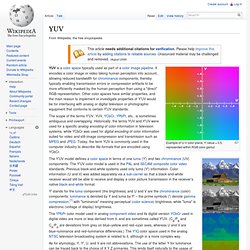
YUV is a color space typically used as part of a color image pipeline. It encodes a color image or video taking human perception into account, allowing reduced bandwidth for chrominance components, thereby typically enabling transmission errors or compression artifacts to be more efficiently masked by the human perception than using a "direct" RGB-representation. Other color spaces have similar properties, and the main reason to implement or investigate properties of Y'UV would be for interfacing with analog or digital television or photographic equipment that conforms to certain Y'UV standards. The scope of the terms Y'UV, YUV, YCbCr, YPbPr, etc., is sometimes ambiguous and overlapping. Video. Video is an electronic medium for the recording, copying and broadcasting of moving visual images.

History[edit] Video technology was first[citation needed] developed for cathode ray tube (CRT) television systems, but several new technologies for video display devices have since been invented. Charles Ginsburg led an Ampex research team developing one of the first practical video tape recorder (VTR). In 1951 the first video tape recorder captured live images from television cameras by converting the camera's electrical impulses and saving the information onto magnetic video tape.
Video recorders were sold for $50,000 in 1956, and videotapes cost $300 per one-hour reel.[1] However, prices gradually dropped over the years; in 1971, Sony began selling videocassette recorder (VCR) decks and tapes to the public.[2] After the invention of the DVD in 1997 and Blu-ray Disc in 2006, sales of videotape and recording equipment plummeted. YPbPr. YPBPR is the analog video signal carried by component video cable in consumer electronics.

The green cable carries Y, the blue cable carries PB and the red cable carries PR. YPBPR[1] is a color space used in video electronics, in particular in reference to component video cables. YPBPR is the analog version of the YCBCR color space; the two are numerically equivalent, but YPBPR is designed for use in analog systems whereas YCBCR is intended for digital video. YPBPR cables are also commonly referred to as Yipper cables[by whom?]. [2] YPBPR is commonly called "component video" by manufacturers, but this is imprecise, as there are many other types of component video, most of which are some form of RGB. Technical details[edit] YPBPR is converted from the RGB video signal, which is split into three components: Y, PB, and PR. Sending a green signal would be redundant, as it can be derived using the blue, red and luma information.
The same cables can be used for YPBPR and composite video. YCbCr. A visualization of YCbCr color space The CbCr plane at constant luma Y'=0.5 A color image and its Y, CB and CR components.
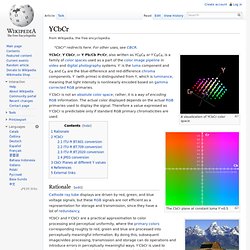
The Y image is essentially a greyscale copy of the main image. Y′CbCr is not an absolute color space; rather, it is a way of encoding RGB information. Chrominance. Component video.